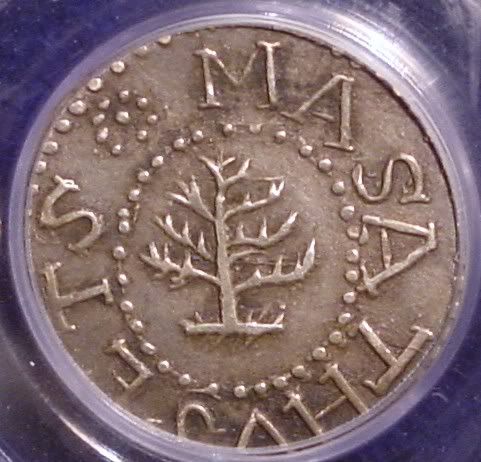A Pine Tree 3 Pence Completes My Denomination Set of Mass. Silver
My main focus was on the auction at this Baltimore show, but I did spend a lot of time on the bourse. There were a few wonderful coins there, but they were not be this time.
The one big piece I did buy on the bourse was the Massachusetts Pine Tree 3 pence. These tiny coins are scarce but they sell for prices that are similar to the much more common shillings because the collector demand for them is much less. This piece is a Noe 36. It is also listed as W-640 in David Bowers' wonderful book on U.S. colonial coins. The Universal Rarity Scale (URS) rating is 9 which translates to an estimated population of 125 to 249 pieces. My guess is the population is in the lower range of that increment with less than 200 pieces known.


Now I have an Oak Tree 2 pence, a Pine Tree 3 Pence, a Pine Tree 6 pence and three shillings (Oak Tree, Large Pine Tree and Small Pine Tree). I doubt that this collection will grow because I don't collect varieties and the Oak Tree 3 and 6 pence pieces are very, very scarce and often in low grades. As for the NE and Willow Tree coins, I'll leave those to the museums and the specialists.
The one big piece I did buy on the bourse was the Massachusetts Pine Tree 3 pence. These tiny coins are scarce but they sell for prices that are similar to the much more common shillings because the collector demand for them is much less. This piece is a Noe 36. It is also listed as W-640 in David Bowers' wonderful book on U.S. colonial coins. The Universal Rarity Scale (URS) rating is 9 which translates to an estimated population of 125 to 249 pieces. My guess is the population is in the lower range of that increment with less than 200 pieces known.


Now I have an Oak Tree 2 pence, a Pine Tree 3 Pence, a Pine Tree 6 pence and three shillings (Oak Tree, Large Pine Tree and Small Pine Tree). I doubt that this collection will grow because I don't collect varieties and the Oak Tree 3 and 6 pence pieces are very, very scarce and often in low grades. As for the NE and Willow Tree coins, I'll leave those to the museums and the specialists.
Retired dealer and avid collector of U.S. type coins, 19th century presidential campaign medalets and selected medals. In recent years I have been working on a set of British coins - at least one coin from each king or queen who issued pieces that are collectible. I am also collecting at least one coin for each Roman emperor from Julius Caesar to ... ?
0
Comments
Everything about that coin screams "SWEET!"
Love the details on the coin....almost 400 years old and looking like that...wow!
I still need a MASS silver example and would love something like that, but I don't think finances allow it yet (I still have a pre-college son that I have to prepare for
I've been told I tolerate fools poorly...that may explain things if I have a problem with you. Current ebay items - Nothing at the moment
--Severian the Lame
Well played.
Betts medals, colonial coins, US Mint medals, foreign coins found in early America, and other numismatic Americana
Mike
Looking for Top Pop Mercury Dime Varieties & High Grade Mercury Dime Toners.
<< <i>Super coin! What does she grade? >>
"She" is a PCGS AU-55. This 6 pence is also an AU-55, and think that this piece is my best preserved piece of Mass. silver.
The thing I really like about Massachusetts silver is that it was so successful. John Hull and Robert Sanderson produced these coins for at least 30 years (1652 to 1682), and they saw a lot of use. There were even pictures of them in 19th century books that banks used to identify coins with which they might come in contact during their course of business. I have no doubt that there were varieties of these coins that were used to senility and then melted. What we have available to us as collectors today is only a small fraction of the original mintage.
The Spanish empire issued the most successful coinage in the Americas by far, but within what would become The United States, the Massachusetts silver coins were the longest running, most successful issue until the U.S. mint opened in 1793.
http://www.coinraritiesonline.com/index.php?page=search&task=det_pl&offset=0&gal_id=1&PHPSESSID=gr1v84i60nkamca987d3vp9de2
--Severian the Lame
<< <i>AU-55 AND green beaned, I believe?
http://www.coinraritiesonline.com/index.php?page=search&task=det_pl&offset=0&gal_id=1&PHPSESSID=gr1v84i60nkamca987d3vp9de2 >>
Yes the 3 pence is "green beaned"; the 6 pence is not; but I don't think it would have any trouble getting a green bean if I sent it in.
I knew it would happen.
I, too, have started building a Mass. silver set. It didn't start out that way, but after I got my first, I had to have more. I will be sticking with the Pine Tree issues (for now!) - I've got the threepence and a small planchet shilling, need a six and a large planchet...alas, my examples saw a bit more commerce than your beauties...
mbogoman
https://pcgs.com/setregistry/collectors-showcase/classic-issues-colonials-through-1964/zambezi-collection-trade-dollars/7345Asesabi Lutho
Coinfame,Kaelasdad,Type2,UNLVino,MICHAELDIXON
Justacommeman,tydye,78saen,123cents,blue62vette,Segoja,Nibanny
Roger